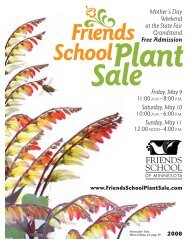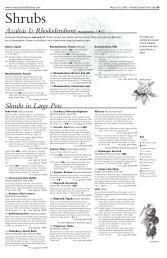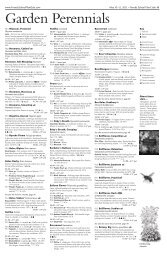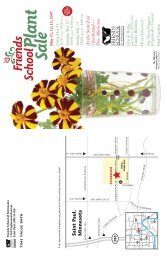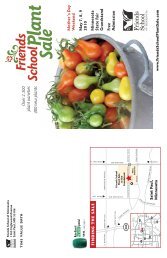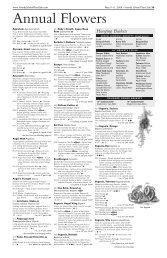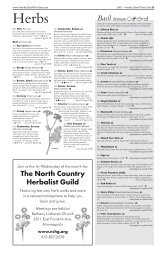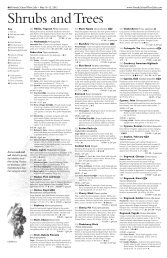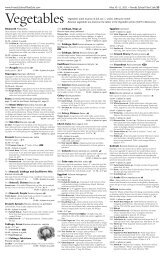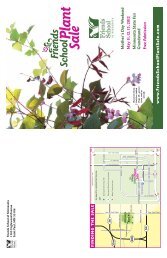2005 Catalog (PDF: 2.9MB) - Friends School Plant Sale
2005 Catalog (PDF: 2.9MB) - Friends School Plant Sale
2005 Catalog (PDF: 2.9MB) - Friends School Plant Sale
Create successful ePaper yourself
Turn your PDF publications into a flip-book with our unique Google optimized e-Paper software.
Peonies<br />
continued from page 1<br />
<strong>2005</strong> • <strong>Friends</strong> <strong>School</strong> <strong>Plant</strong> <strong>Sale</strong> 23<br />
Lady’s Slipper continued<br />
O011 C. parviflorum var. pubescens, Yellow Lady’s<br />
Slipper—The easiest of all orchids to<br />
grow, according to Dr. Edgar T. Wherry,<br />
and can live up to 100 years. Blooms in<br />
May. Most shade-tolerant of the lady’s<br />
slippers. Rootstock rescued from development.<br />
12-18” ˜—in a large pot $35.00<br />
O012 C. reginae, Pink and White Showy Lady’s<br />
Slipper—Our largest and showiest native<br />
orchid. Blooms from late June into July.<br />
Beautiful contrasting white petals and<br />
sepals with a moccasin-shaped “slipper”<br />
flooded with rose or crimson. Rootstock<br />
rescued from development. 18-36” ˜<br />
—in a large pot $50.00<br />
These prices are for single-stem, blooming-size<br />
plants. We will also have smaller sizes for less<br />
and multiple stem plants for more.<br />
O013 Lady’s Tresses, Fragrant<br />
Spiranthes cernua odorata<br />
Porcelain white 12” spires of sweetly scented<br />
flowers over 3-4” foliage on this eastern North<br />
American native orchid. Long-lasting cut<br />
flower. Damp organic soils preferred. 12” Í∏<br />
—in a 2.5” pot $4.00<br />
O014 Lily, Martagon Lilium martagon<br />
Up to 40 recurved lilies dangle like elegant candelabras.<br />
Very easy to grow, preferring part shade<br />
but also fine in sun. Self-sows in a good site. A<br />
European wildflower. 36-72” Í∏<br />
—in a 4.5” pot $12.00<br />
O015 Marsh Helleborine<br />
Epipactis palustris ◊<br />
European native with purplish green flowers<br />
with red veins and yellow dots from June to<br />
September. Four to 20 blooms on a single<br />
spike. Moist or boggy alkaline soil. Will spread<br />
in the right spot. 20” Í∏<br />
—in a 4” pot $20.00<br />
O016 Orchis, Showy Orchis spectabilis<br />
Very difficult native orchid, it requires deep,<br />
well-drained soil with lots of leaf mold. It<br />
definitely needs shade and good air circulation.<br />
Best on a slope that is moist in the spring.<br />
Usually found under sugar maples. 12” spikes<br />
of up to ten one-inch rosy purple white-lipped<br />
flowers in May. Forms nice clumps when<br />
happy. Rootstock rescued from development.<br />
Ó˜ —in a 4.5” pot $15.00<br />
O017 Peony, Anomalous<br />
Paeonia anomala ◊<br />
A thread-leafed herbaceous species originally<br />
from central Asia, with finely cut foliage.<br />
Brilliant pinkish crimson blooms 4” across. Í<br />
—in a 1 gal. pot $50.00<br />
O018 Peony, Chinese Mountain<br />
Paeonia obovata ◊<br />
A very choice herbaceous species peony native<br />
to the mountains of China. Single pink blooms<br />
in spring, followed by brilliant orange-red<br />
calyces with bluish-black shiny seeds that persist<br />
for many weeks, brighten up a shady corner.<br />
This is a woodland peony! ∏Ó<br />
—in a 1 gal. pot $50.00<br />
Peony, Fern-Leaf Paeonia tenuifolia<br />
Considered a collectible. Fern-leaf foliage easily<br />
distinguishes it from other herbaceous varieties.<br />
Well-drained,even sandy soil—it doesn’t<br />
like wet feet. Blooms May-June. 18” Í<br />
O019 P. tenuifolia ◊—Brick red single flowers<br />
with feathery foliage. German garden<br />
stock. —in a 4” jumbo pot $20.00<br />
O020 P. tenuifolia ‘Plena’—Double red flowers<br />
on a compact plant. Very floriforous.<br />
Sterile; will not set seed.<br />
—in a 1 gal. pot $40.00<br />
Julia Rose Intersectional Peony<br />
Peony, Intersectional Paeonia ◊<br />
Intersectional or Itoh peonies resulted from<br />
crosses between herbaceous and woody<br />
peonies. The flowers resemble those of woody<br />
peonies, and the stronger stems keep the plant<br />
from flopping, as happens with herbaceous<br />
peonies. Like herbaceous peonies, though,<br />
they need to be cut back to the ground each<br />
spring.<br />
The intersectionals we are offering were<br />
bred in Wisconsin by Roger Anderson and are<br />
newly available to the <strong>Plant</strong> <strong>Sale</strong>. They are particularly<br />
easy to grow; they need only welldrained<br />
soil, plenty of sun and a mulch during<br />
their first winter. Supply limited. Í<br />
O021 Pastel Splendor—single white with light<br />
pink and yellow shades upon opening,<br />
red flare.<br />
Canary Brilliants—full double canary<br />
yellow with lemon fragrance.<br />
Julia Rose—single to semi-double opening<br />
cherry red to orange and later yellow;<br />
flowers in three colors at the same time.<br />
Callies Memory—yellow-cream 6–8”<br />
blossoms with maroon flares and picotee<br />
edge; semi-double to double.<br />
—in a 2 gal. pot $200.00<br />
O022 Bartzella—A peony of some notoriety—<br />
probably related to its price. It has deep<br />
yellow flowers with a lemon fragrance.<br />
Blooms to 9.5 inches on established<br />
plants. Bloom period from two weeks to<br />
a month. As many as 60 blooms per<br />
mature plant. As U of M Professor<br />
Emeritus Mervin Eisel said in a letter to<br />
Roger Anderson, the breeder of Bartzella,<br />
“I will never forget the thrill it was when<br />
I saw it for the first time.” (See picture at<br />
lower right.) —in a 2 gal. pot $250.00<br />
O023 Peony, Japanese Forest<br />
Glaucidium palmatum ◊<br />
An exquisite, hard to find Japanese woodlander.<br />
Topping palmate foliage are large openfaced<br />
lilac-pink flowers in spring. This<br />
extremely hardy plant is the ultimate in<br />
elegance for the shaded garden. 18” ∏<br />
—in a one gallon pot $30.00<br />
O024 Peony, Scarlet<br />
Paeonia peregrina ◊<br />
One of the most asked-for species peonies<br />
(shown on our catalog cover). Brilliant red<br />
single flowers with attractive yellow stamens.<br />
Herbaceous peony native to Italy, the Balkans<br />
and Turkey. 20” Í —in a 4” pot $15.00<br />
—in a 1 gal. pot $35.00<br />
O025 Peony, Wittmann’s<br />
Paeonia wittmanniana ◊<br />
A rare herbaceous species from the northwest<br />
Caucasus, the flower color ranges from creamy<br />
white to yellow. The pistils are ruby red surrounded<br />
by yellow stamens. Part shade. Í∏<br />
—in a 4” pot $30.00<br />
Peony, Woody Paeonia suffruticosa<br />
Woody peonies require at least four to five<br />
hours of sunlight daily. Good drainage is essential<br />
in a loamy soil with high humus content to<br />
a depth of at least two feet. Once established,<br />
you will be rewarded each year with an abundance<br />
of beautiful flowers. Woody peonies can<br />
live more than a hundred years. 72” Í∏<br />
O026 Dark Red ‘Taiyo’<br />
O027 Orange ‘Kinkaku’<br />
O028 Purple ‘Shikouden’<br />
O029 Yellow ‘Kinshi’ —in a 1 gal. pot $30.00<br />
O030 Red and White ‘Shimanishiki’ ◊<br />
O031 Peony, Yellow Paeonia lutea ◊<br />
A lovely woody peony with single yellow<br />
flowers. The smaller blooms hold up better in<br />
the rain! 24–120”—probably the shorter end<br />
in our climate, but who knows? Í<br />
—in a 1 gal. pot $50.00<br />
—see other Peonies, page 34<br />
O032 Trillium, Grandiflorum<br />
Trillium grandiflorum ‘Plenum’ ◊<br />
Rarely offered full double form of one of our<br />
most beautiful American wildflowers. The<br />
overlapping rows of white petals recall a<br />
formal double camellia. 12–15” ∏<br />
—in a one gallon pot $75.00<br />
differences among peonies and<br />
to appreciate the amazing range<br />
of types available. I recommend<br />
planting a variety, including<br />
some woody, some herbaceous,<br />
and some of the peony’s cousin<br />
glaucidium. The woody peonies<br />
are almost shrub-sized and<br />
work well as single specimens<br />
in a bed. The herbaceous<br />
peonies create great borders or<br />
clumps of plants. The glaucidium<br />
cousin has a beautiful flower<br />
with fewer petals and wonderful<br />
leaf structure. Among the<br />
herbaceous peonies, the fernleaf<br />
peony has an especially delicate foliage.<br />
The Rogers book is paperbound, with many color photographs.<br />
Clearly titled chapters lead the reader through the history<br />
of the peony, species information, recommended cultivars,<br />
propagation, and more. The appendices include worldwide<br />
peony information, nursery sources, and information on landscaping<br />
with peonies.<br />
The Halda book is hardbound and contains beautiful botanical<br />
illustrations that you could frame for your wall! The book<br />
is divided into two parts: a section on the genus paeonia, and a<br />
section about how to grow peonies. Both sections are easy to<br />
read and use. Both the Halda and Rogers books have excellent<br />
indices.<br />
The Halda book might be better suited for the serious gardener<br />
with an interest in the history and development of the<br />
species. The Rogers book is better for the practical gardener,<br />
whose focus is on which peonies will work in my garden and<br />
how do I grow and take care of them?<br />
My advice after reading these books is to include peonies in<br />
your garden! Peonies are easy to grow and maintain and don’t<br />
get strange diseases or bugs that are hard to control. For as<br />
simple as they are to grow, they have a powerful presence in<br />
the garden; they deserve their association with calm beauty.<br />
Lili Herbert is head of <strong>Friends</strong> <strong>School</strong>’s middle school program.<br />
She gardens at her Midway home<br />
Bartzella Intersectional Peony from the Rogers book; photo by the<br />
breeder of Bartzella, Roger Anderson.<br />
Jarmila Haldova’s illustration of Wittman’s Peony from the Halda book.





